Garmin Enduro review
Garmin Enduro: Specs
Size: 2 x 2 x 0.6 inches
Weight: 2.5 ounce (Steel), 2.15 ounce (Titanium)
Display: 1.4-inch (280 x 280)
Water resistance: 330 feet
GPS: Yes
Smartwatch compatibility: iPhone, Android
Heart rate sensor: Yes
Smartphone notifications: Yes
Battery life: 50 days/65 days with solar
The Garmin Enduro sits a shelf below the beastly Garmin fenix 6 Pro Solar. The Enduro is a bit smaller, a bit more comfortable and a bit less expensive than the fenix 6 series. Otherwise, it offers the same specs, a multitude of sensors, a battery that can last for months and most (but not all) of the smartwatch features that come standard with higher-end Garmins.
Like Garmin’s other adventure watches, I learned during this Garmin Enduro review that it’s meant for a fairly small market. Solar charging is great, but you need to be outside for hours at a time to make the most of it. It’s also a rather bulky device that would turn heads in the office or at a bar. And priced at $800, the Enduro costs hundreds of dollars more than many of the best Garmin watches and best sports watches with comparable features.
Also note the Garmin Enduro won a 2021 Tom’s Guide Award for Health and Fitness. We named it the best smartwatch for the outdoors overall.
Garmin Enduro review: Price and availability
The Garmin Enduro is available now in two versions. I reviewed the Steel with Gray UltraFit Nylon Strap ($799), which has a stainless steel bezel. At 2.5 ounces, it’s a hefty watch, though it’s not quite as large as the Garmin fenix 6X Pro Solar Edition ($899 to $1,049), which is 2.9 ounces and is otherwise the same size as the Enduro.
The other version, the Carbon Gray DLC Titanium with Black UltraFit Nylon Strap ($899), comes with a diamond-like carbon bezel. This case checks in at 0.35 ounces (10 grams) lighter than the Steel version.
Otherwise the specs for the Titanium watch are the same as the Steel. Both come with a Power Glass lens, a nylon band, and a fiber-reinforced polymer case with metal rear cover. The internal sensors and smartphone connectivity options are the same as well.
Garmin Enduro review: Design
I was initially apprehensive about the Garmin Enduro’s design. I have small wrists, and large watches tend to be uncomfortable. Either they slide around my wrist when I wear them (especially when I’m sweaty from running) or I wear them too tight that I end up with clasp indentations or rashes on my wrist.
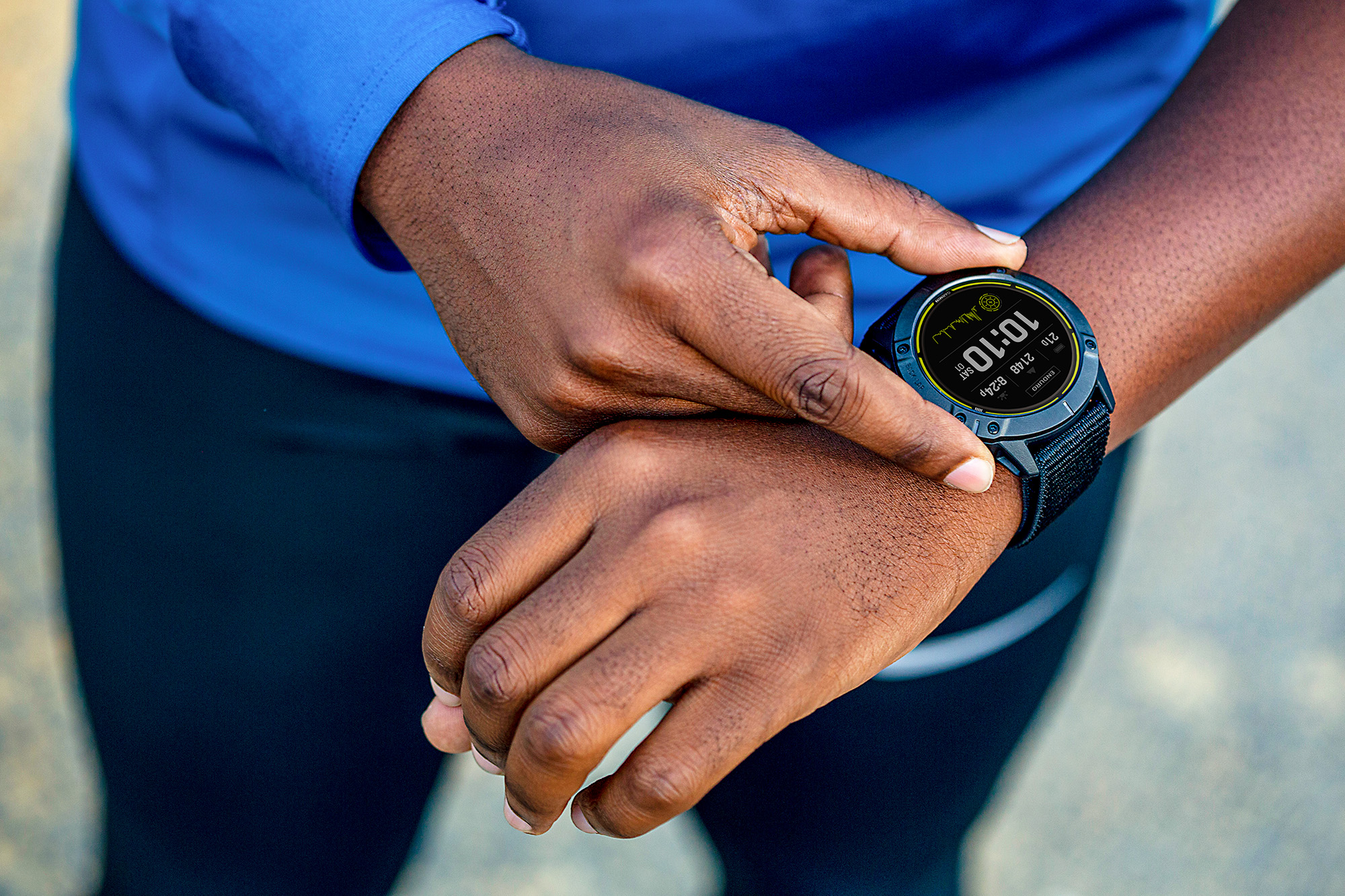
The Garmin Enduro surprised me. It’s rather comfortable for a watch that weighs 2.5 ounces. I credit the 26-millimeter nylon strap, which clasps together with Velcro on the outside, away from the skin.
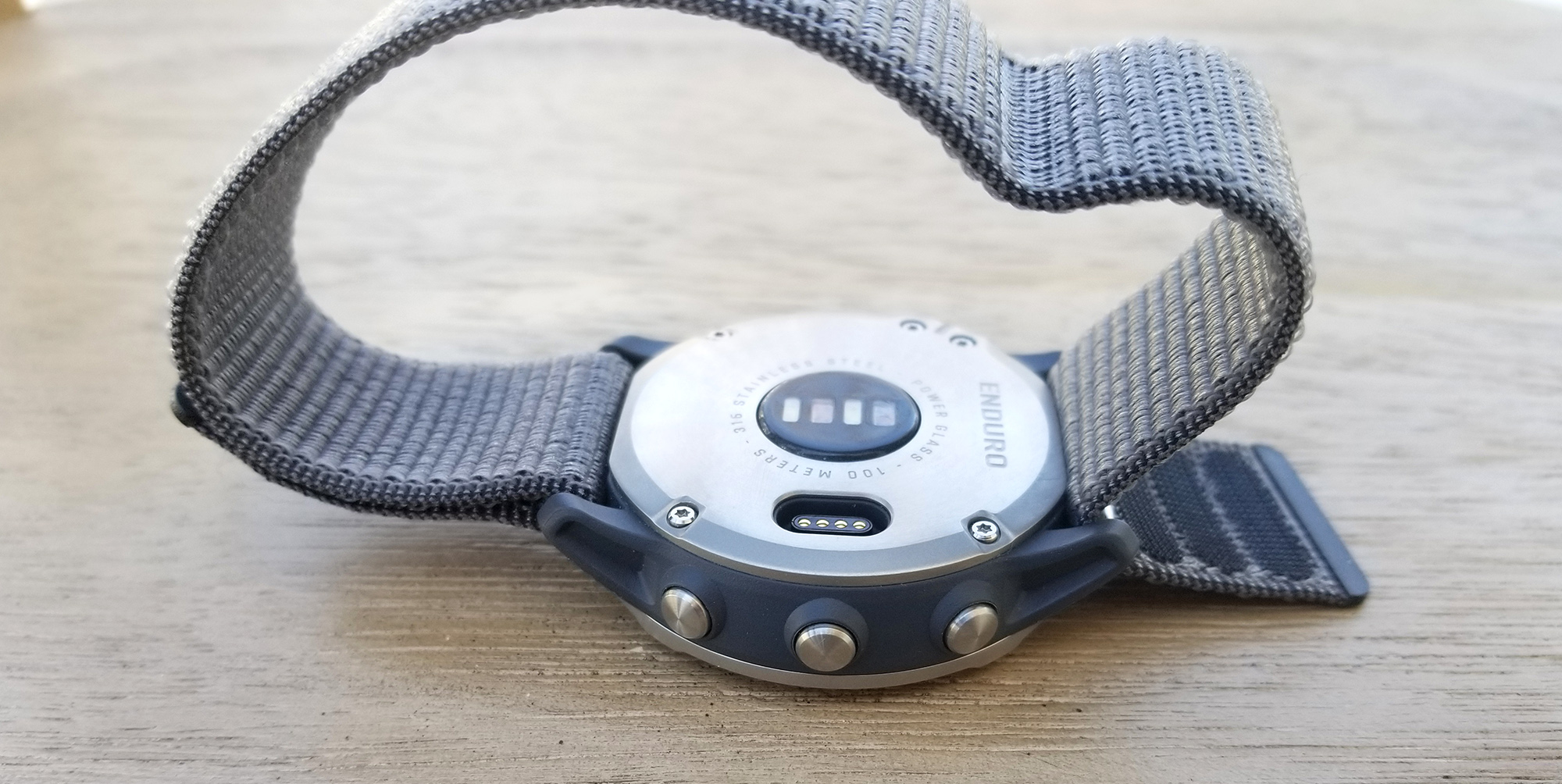
The skin-facing part of the strap is a single piece of material, with no metal clasps or holes. I could comfortably tighten the strap, and I didn’t even mind wearing the Garmin Enduro in my sleep. This gives the Enduro a leg up on the fenix 6 Pro Solar, which comes with silicone or titanium bracelet straps.
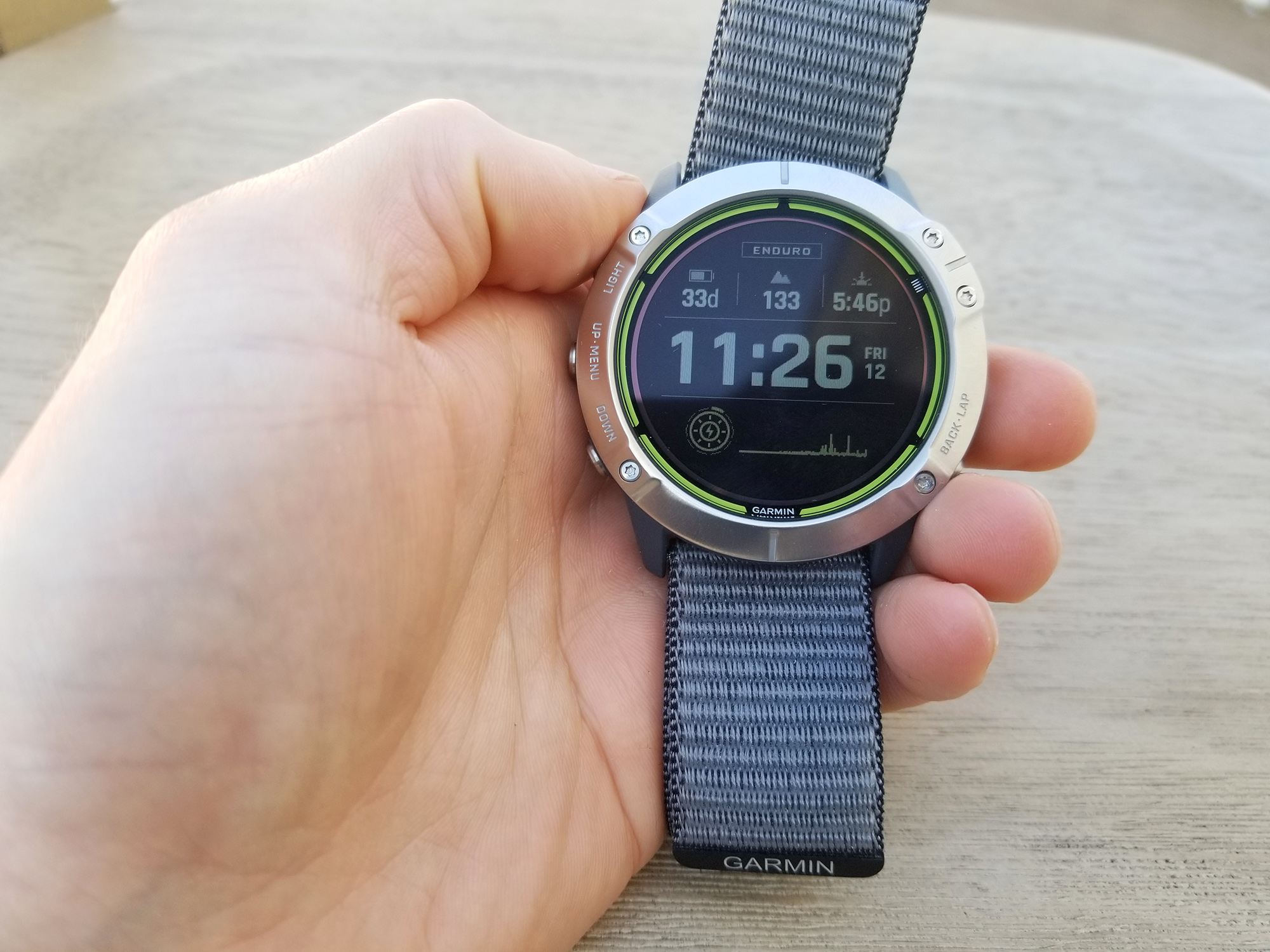
Overall, the Garmin Enduro is still more functional than stylish. The visible screw heads in the bezel and the button labels make it clear that it’s meant to be a rugged sports watch. If you wear the Garmin Enduro to the office, be prepared for your coworkers to notice it and ask about it.
But it’s not really an office watch. Instead it’s designed to withstand the outdoor elements. It comes with a Military Standard 810 rating, meaning it can take extreme heat, cold, and submersion in water up to nearly 330 feet.
Garmin Enduro review: Activity tracking and sensors
The Garmin Enduro tracks a range of activities, with a nod toward trail running, cross-country skiing, and other “outdoorsy” sports. The watch lets you set Favorites for tracking; that way, if you do yoga frequently, you don’t have to scroll all the way to the end of the alphabetically-ordered menu to find it.
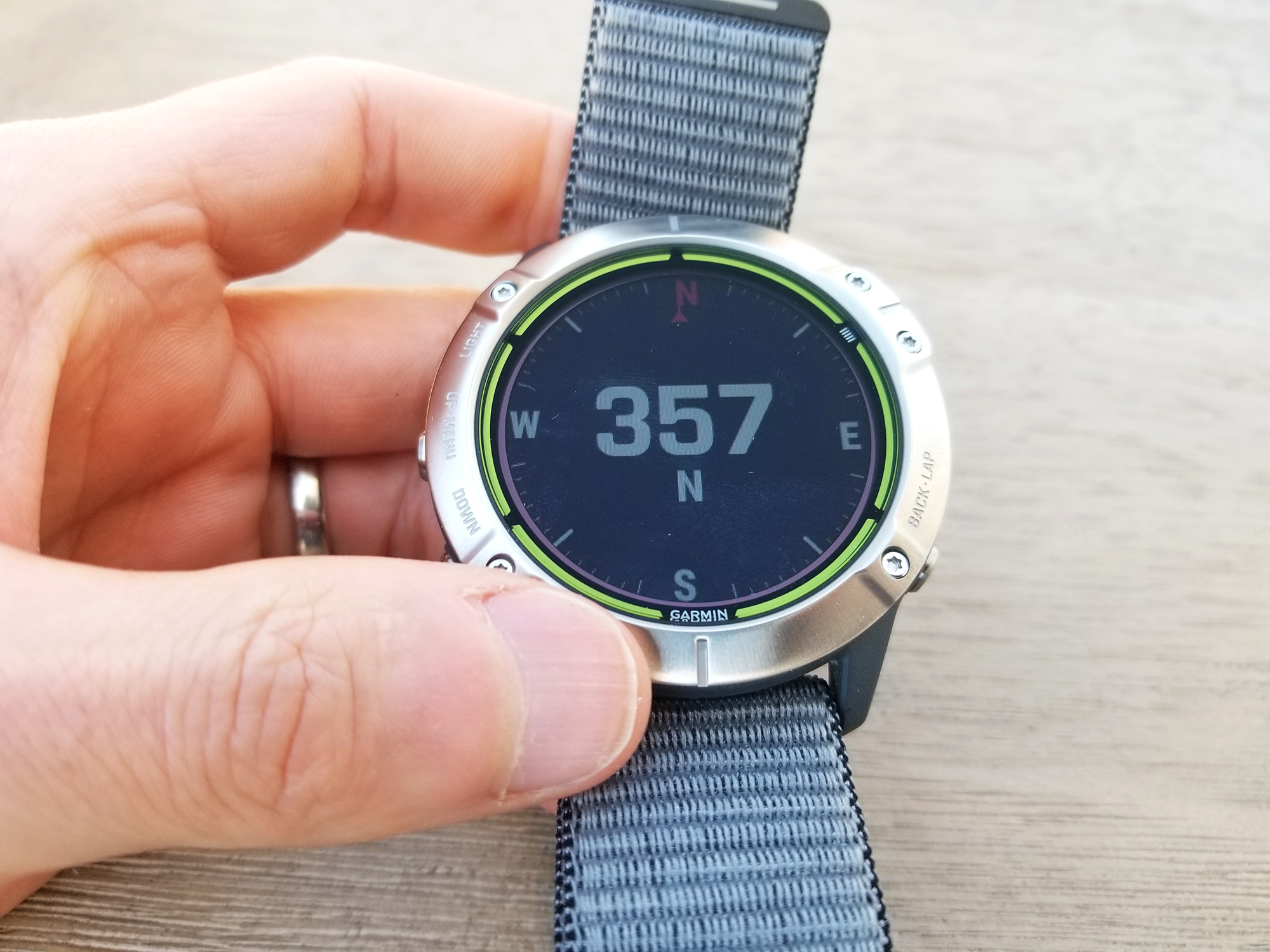
Like most Garmin watches, the Enduro is easy to use for tracking runs. It finds a GPS signal quickly, pauses and resumes runs with a single button push, and provides audible beeps at each mile mark. The watch was comfortable on my long runs, and despite its size I barely noticed it. (Unfortunately, COVID-19 travel restrictions prevented me from testing the watch deep in the woods, and it was a bit too cold in early March for kayaking.)
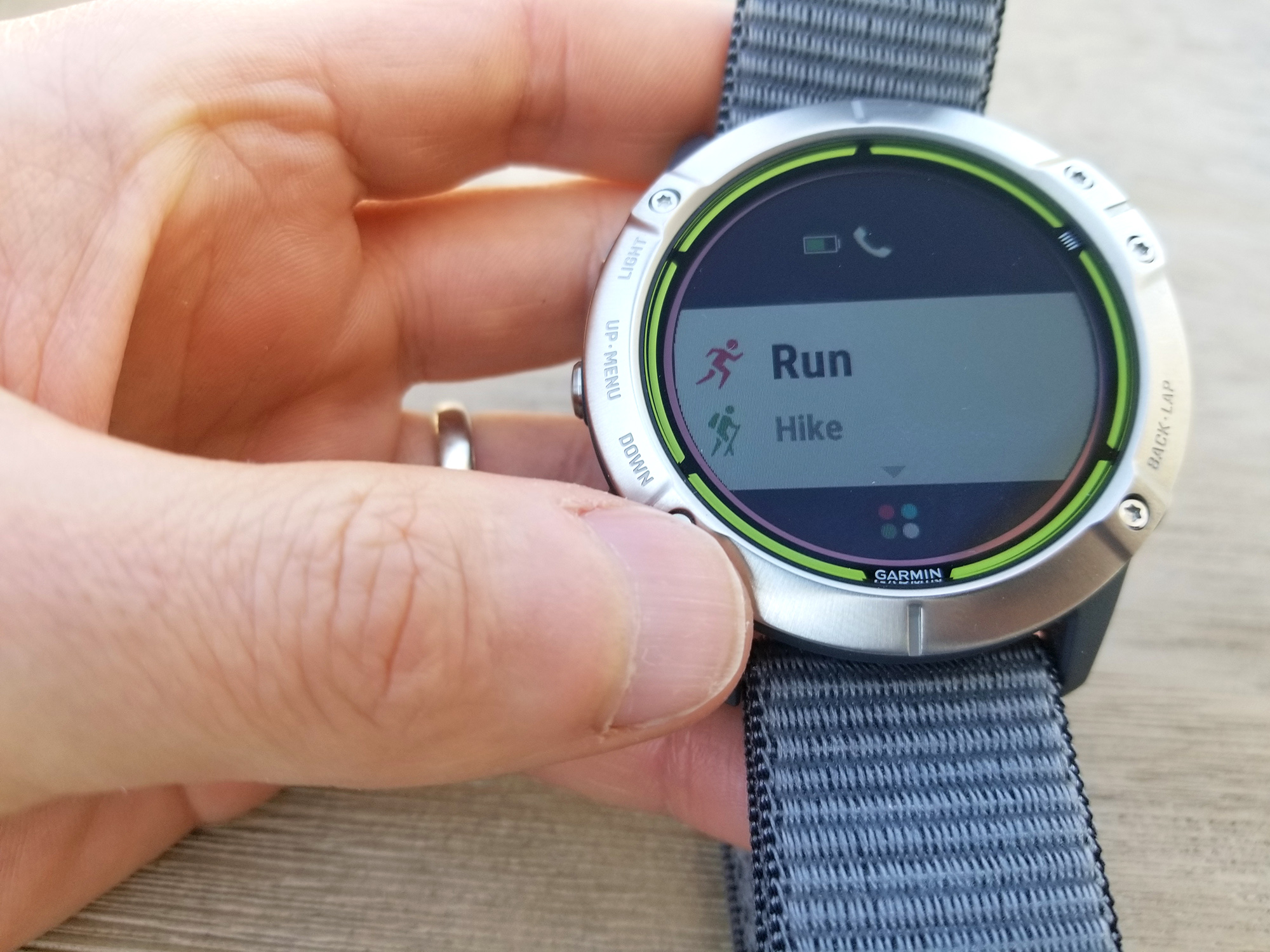
The Garmin Enduro comes with a range of sensors you might find on the best fitness trackers, including an altimeter, compass, accelerometer and thermometer. The weather information read consistent with my smartphone’s forecast, though sometimes it needed a manual refresh to update. In addition to weather tracking, the Garmin Enduro will tell you sunrise and sunset times. Anyone who tries to sneak in a workout before it gets too dark in the evening will appreciate this feature. I used it much more often than I expected.
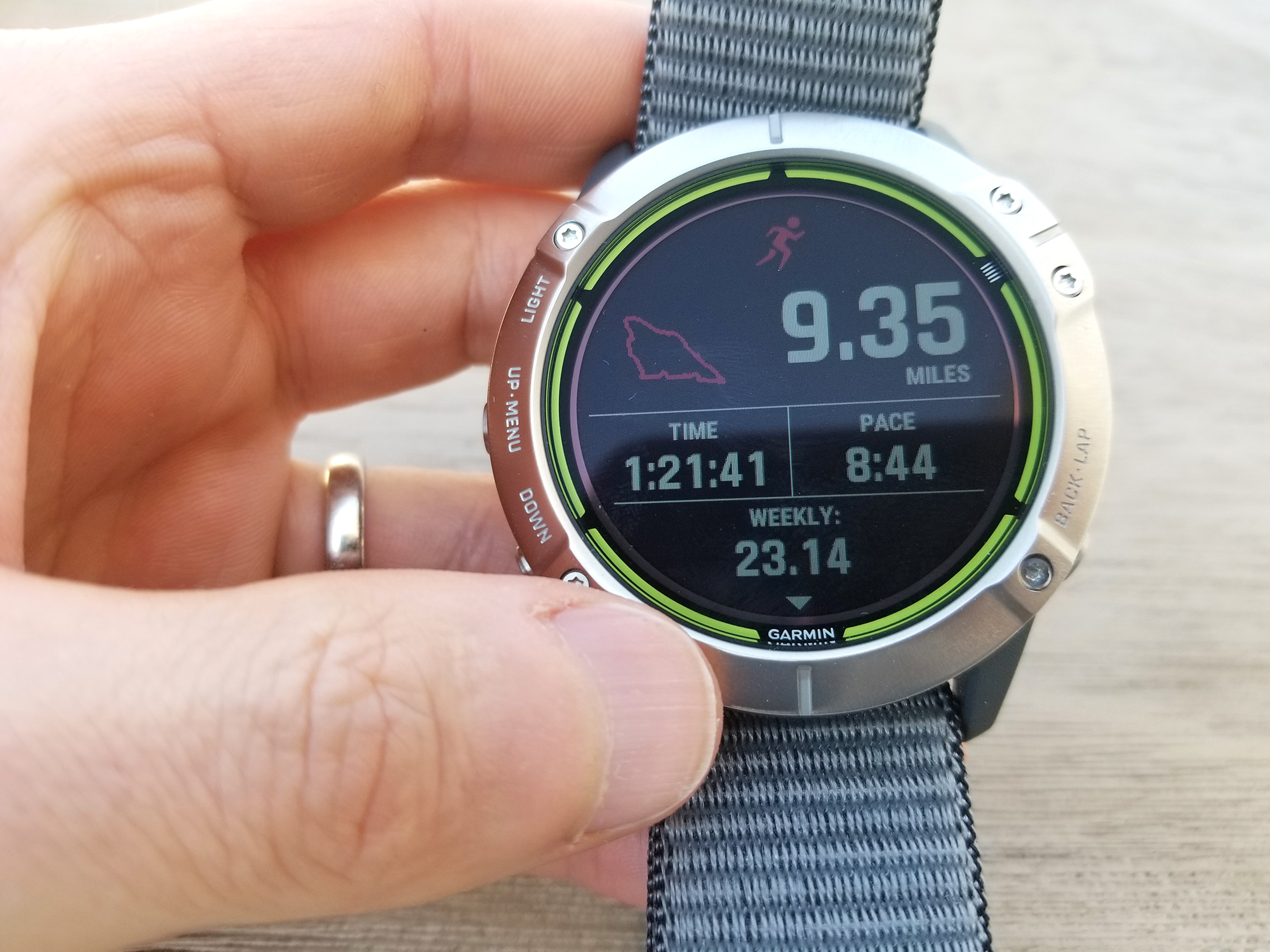
On the other hand, the altimeter underwhelmed me. Over the course of two weeks of wearing the watch, the Garmin Enduro showed the elevation at home at anywhere from -50 feet to more than 200 feet. The actual elevation in my neighborhood is about 30 feet. It’s possible to manually recalibrate the altimeter, and it wasn’t a big deal for city running, but this could be an issue for anyone hiking or biking in the mountains and relying on accurate elevation information for navigation.
Garmin Enduro review: Smartwatch features
The Garmin Enduro comes with many of the same smartwatch features of newer Garmin models. Mobile payments are supported through Garmin Pay; you can also receive smartphone notifications. (Android users also have the ability to respond to text messages and reject phone calls.) You can also sync with Garmin Connect IQ to download watch apps, though options are limited mostly to wellness, fitness and music apps.
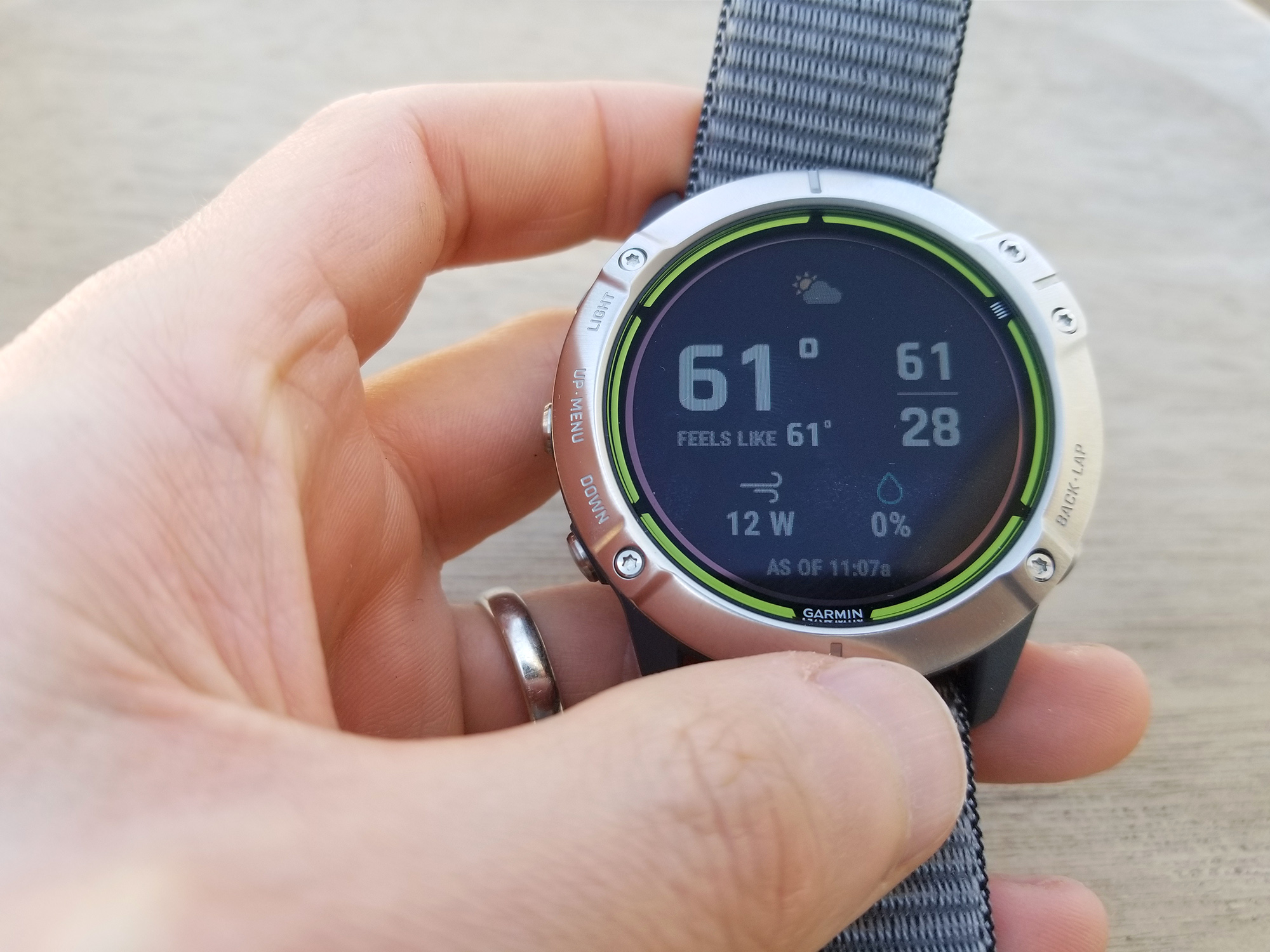
Music storage is another limitation. The Garmin Enduro can control music playing from your smartphone but doesn’t have native music storage, unlike less-expensive Garmin watches such as the Forerunner 245 Music ($349), the Forerunner 745 ($499) or the Forerunner 945 ($599).
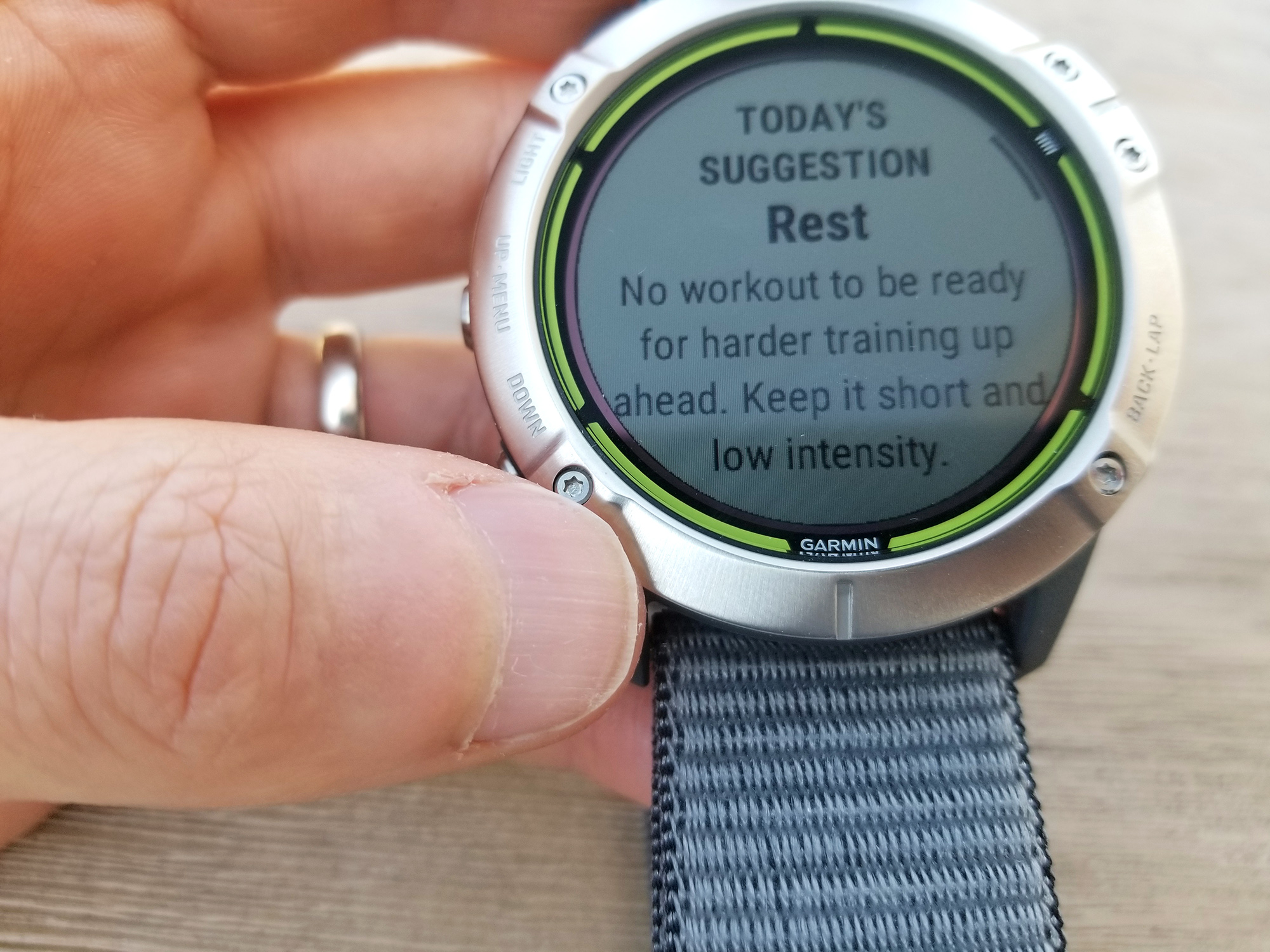
Compared to leading devices such as the Apple Watch Series 6 ($399) or Samsung Galaxy Watch 3 ($399), the Garmin Enduro isn’t the most well-rounded smartwatch. Then again, the Enduro hasn’t been designed for the smartwatch crowd.
Garmin Enduro review: Battery life
According to Garmin, the Enduro’s battery will last 50 days in smartphone mode on a single charge. Solar charging will boost the estimate to 65 days. The watch will last 70 hours in GPS mode, or 80 hours with solar charging. When you’re starting to track an activity using GPS, the watch provides an indication of how long the battery will last in GPS mode, which is a nice touch.
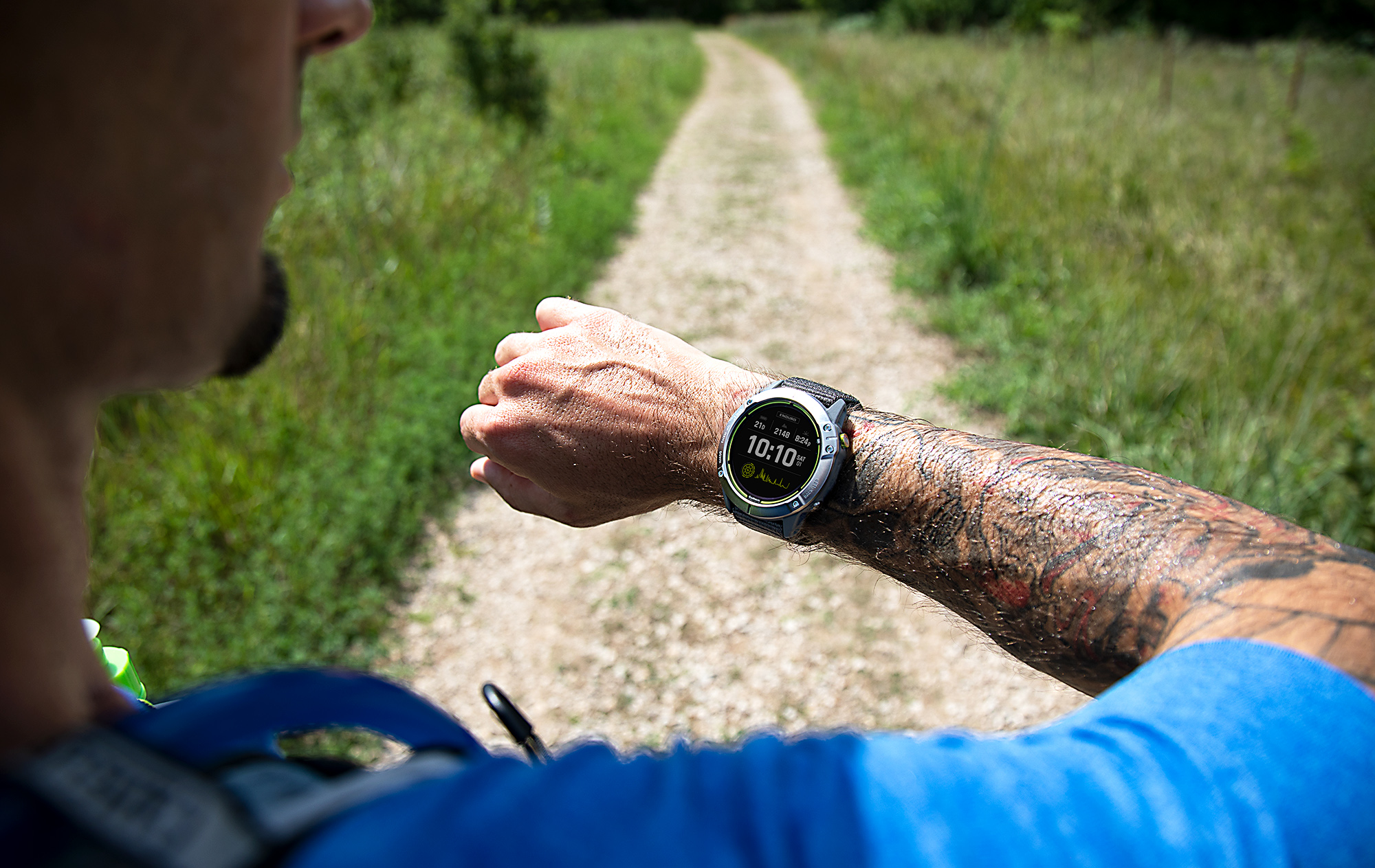
After one week of wearing the Garmin Enduro, which included roughly 4.5 hours of outdoor running, the battery was still at 80%, or 40 hours remaining. After two weeks, the battery had 31 days remaining. Extrapolating, this means I’d be able to go more than a month before charging the Garmin Enduro, which is fairly consistent with the manufacturer specs.
The Garmin Enduro has a few different battery-saving options. Max Battery GPS Mode pings a satellite less frequently, while Expedition GPS modepings a satellite only once an hour. These settings are clearly meant for multi-day adventures. Jacket Mode, which can be enabled if you plan to wear the watch over clothing, will disable the heart rate monitor and extend the battery life.
The chart below compares the battery life specifications for the Garmin Enduro, Instinct ($399), and fenix Pro 6 Solar. By and large, the Enduro tops the chart, though Garmin says the Instinct will never need a charge if you leave it in Battery Saver mode.
| Enduro | Instinct | Fenix 6 Pro Solar | |
| Normal use | 50 days | 24 days | 21 days |
| Normal use with Solar | 65 days | 54 days | 24 days |
| Battery Saver | 130 days | 56 days | 80 days |
| Battery Saver with GPS | 1 year | Unlimited | 120 days |
| GPS | 70 hours | 30 hours | 60 hours |
| GPS with solar | 80 hours | 38 hours | 66 hours |
| Max Battery GPS | 200 hours | 70 hours | 120 hours |
| Max Battery GPS with solar | 300 hours | 145 hours | 148 hours |
| Expedition GPS | 65 days | 28 days | 46 days |
| Expedition GPS with solar | 95 days | 68 days | 56 days |
Solar charging is definitely a plus, but there’s a catch: You need to wear the watch outside at least three hours per day in 50,000 lux conditions, which equates to an overcast day. (The same is true of the fenix 6 Pro Solar.) This is a handy feature for those outdoor excursions hours away from a wall socket, but it’s unlikely to extend the battery of the Garmin Enduro if you’re sitting at a desk all day and only heading outside for shorter runs or rides.
Garmin Enduro review: Verdict
The market for solar-powered sports watches remains limited. Many are designed for remote adventures like deep-sea diving, and while GPS and weather sensors are common, heart rate monitors are hard to find. The Casio G-SHOCK GBDH1000-1 ($399) combines a heart rate monitor and GPS with solar charging, but the battery life in GPS mode is 18 hours at best. Meanwhile, you can get 20 days of battery life (and 20 hours of continuous GPS use) for just $109 with the Military Standard 810 rated Amazfit T-Rex, even though it lacks solar-charging capabilities.
The Garmin Enduro is in a small class. Its closest competition is Garmin’s own fenix 6 Pro Solar, which is larger, less stylish, and more expensive. The Enduro is a solid and functional sports watch – it’s a Garmin, after all – but like the fenix 6 it seems to be designed for a very specific type of athlete who spends hours, days, and even weeks in the outdoors.
Most users, though, won’t reap the benefits of solar charging or Expedition GPS mode when they wear the Garmin Enduro every day. Unless you truly need a watch that you only have to charge once a month, other Garmins will do just fine.
For all the latest Technology News Click Here
For the latest news and updates, follow us on Google News.
